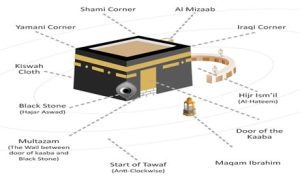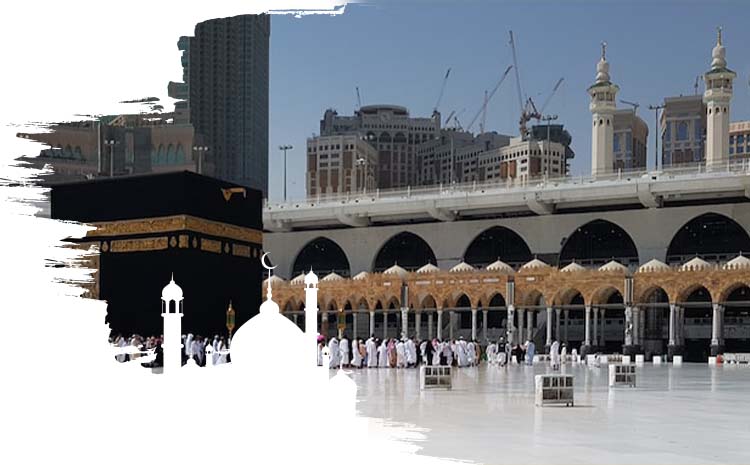How To Perform Umrah?
- Introduction: Umrah, also known as the lesser or minor It consists of four essential practices and carrying out a set of rites in the precinct of Masjid al-Haram in Makkah. Four essentials are passing the Miqat in the state of Ihram, performing Tawaf of the Kaaba, doing Sa’i of Safa and Marwa, and carrying out Halq (shaving) or Taqsir (shortening) of the hair. Umrah can be performed throughout the year, although it is disliked carrying out the pilgrimage during the days of Hajj which take place between the 9th and 13th of Dhul Hijjah. The rites carried out during Umrah also form an integral part of Hajj itself. It is a sacred journey undertaken by millions of Muslims each year. Every Muslim with to to peform Umrah.
- Is Umrah a Fardh? The Prophet ﷺ performed Umrah four times during his life. There is a difference of opinion among different schools of thought as to whether performing Umrah at least once in a person’s lifetime is compulsory or not. According to the Hanafi and Maliki schools of thought, Umrah is not Fardh (obligatory), but is considered a Sunnah Mu’akkadah (emphasised Sunnah). On the other hand, the performance of Umrah is considered Fardh according to the Shafi’i and Hanbali schools of thought, just like Hajj.
- Benefits of Umrah.
- Abu Hurairahnarrate: Allah’s Messenger ﷺ said, ‘(The performance of) Umrah is an expiation for the sins committed (between it and the previous one).’ [Narrated in Sahih al-Bukhari]
- Abdullah ibn Abbassaid: The Messenger of Allah ﷺ said: ‘Perform Hajj and Umrah consecutively; for they remove poverty and sin as the furnace removes impurity from iron.’ [Narrated in Sunan al-Nasa’i]
- Two Types of Umrah
- Umrah al-Mufradah. This type of Umrah is performed independently to Hajj and can be carried out at any point during the year, except during the days of Hajj.
- Umrah al-Tamattu. This type of Umrah is performed in conjunction with Hajj and is normally carried out in the month of Dhul Hijjah, just before the commencement of Hajj. This Hajj is known as Hajj al-Tamattu and is the most common and easiest type performed by pilgrims.
- Conditions for Umrah
- Maturity. you must have reached puberty i.e., you are Baligh.
- Sanity. you must be mentally sound and in full control of your mental faculties.
- Financially able. you must have sufficient expenses to cover travelling, accommodation and all other requirements during your Umrah. You must also have sufficient expenses to support your dependents during your absence. Being debt-free isn’t a prerequisite, although arrangements for debts to be fulfilled should be made prior to going on Umrah.
- Physically able. you must be physically capable of travelling to Makkah and performing the rites of Umrah. You should be free from any illnesses or diseases that would restrict you from doing so.
- Safe Travelling. Travelling should also be safe i.e., you shouldn’t be in any danger of being harmed during your trip.
- Free from Iddah period (women only). females must not be from their Iddah period, if applicable.
- Overview of Kaaba


- Obligations (Wajibaat) of Umrah:
- Entering state of Ihraam from Meeqat.
- Shaving the head or cutting the hair.
- Omission of an Essential: Remember that Umrah becomes invalid if any essential parts (Faraidh) are omitted, whereas if an obligatory act (Wajibbat) is omitted, Umrah is still valid, but the one who omits it must offer a compensatory sacrifice of a sheep/goat called “Dam” for each omission of obligatory act.
- Four Essentials of Umrah
- Step 1: Ihram and Entering the State of Pilgrimage: Ihram (Arabic: إحرام) refers to the sacred state a pilgrim must enter before carrying out the rites of Hajj and Umrah. The pilgrim must enter this state after cleansing the body, wearing the prescribed attire, and making the intention, before crossing the designated Miqat (Arabic: ميقات) refers to the boundary where it becomes necessary for pilgrims to adorn the Ihram garments and impermissible to pass except in the state of Ihram. Those who cross the boundary without having entered the state of Ihram must perform an animal sacrifice (Damm) as expiation.
- Ihram Essentials
- Purity. Clip the nails, remove unwanted hair under the armpits and navel and trim the moustache.
- Bathe. Do Ghusl (bath) or at the very least, Wudhu (ablution).
- Ihram clothing. Before reaching the Miqat, put on the Ihram. For men, this is two sheets of white cloth. For women, regular modest clothing will suffice. It is recommended to put on the Ihram at the airport before departure.
- Salah of Ihram.Perform two Rakahs of Salah after putting on the Ihram. Recite Surah al-Kafirun (Surah 109) in the first Rakah and Surah al-Ikhlas (Surah 112) in the second after al-Fatiha. Make Dua after the Salah.
- Niyyah. Make your Niyyah for Umrah as you approach the Miqat, preferably in the plane. Make sure you remove any clothing that violates the conditions of Ihram. It is recommended to make a verbal intention. This may be done in any language.
لَبَّيْكَ اللَّهُمَّ عُمْرَة
Labbayka llāhumma ‘umratan.
O Allah, here I am to perform Umrah. - Talbiyah. Recite the Talbiyah:
لَبَّيْكَ اللهُمَّ لَبَّيْكَ – لَبَّيْكَ لَا شَرِيْكَ لَكَ لَبَّيْكَ – إِنَّ الْحَمْدَ وَالنِّعْمَةَ لَكَ وَالْمُلْكَ – لَا شَرِيْكَ لَكَ –
Labbayka llāhumma labbayk(a), labbayka lā sharīka laka labbayk(a), inna l-ḥamda wa n-ni’mata, laka wa l-mulk(a), lā sharīka lak.
At Your service, Allah, at Your service. At Your service, You have no partner, at Your service. Truly all praise, favour and sovereignty is Yours. You have no partner.
Men should chant the Talbiyah audibly and women should recite quietly. Send Salawat on the Prophet ﷺ and make Dua after pronouncing the Talbiyah. - To Makkah. Proceed to Makkah while reciting Talbiyah, Dhikr and Salawat.
- Enter Masjid al-Haram. Upon reaching Masjid al-Haram, enter with your right foot, preferably through Bab al-Salam and recite the Dua for entering the mosque.
- Dua at the Kaaba. Keep your gaze lowered until you see the Kaaba. Upon seeing it, say Allāhu akbar. Allāhu akbar. Lā ilāha illa-llāh three times. Raise your hands, make an abundance of Dua and send Salawat on the Prophet ﷺ.
- Ihram Essentials
- Step 1: Ihram and Entering the State of Pilgrimage: Ihram (Arabic: إحرام) refers to the sacred state a pilgrim must enter before carrying out the rites of Hajj and Umrah. The pilgrim must enter this state after cleansing the body, wearing the prescribed attire, and making the intention, before crossing the designated Miqat (Arabic: ميقات) refers to the boundary where it becomes necessary for pilgrims to adorn the Ihram garments and impermissible to pass except in the state of Ihram. Those who cross the boundary without having entered the state of Ihram must perform an animal sacrifice (Damm) as expiation.
- Step 2: Tawaf – Circumambulation of the Kaaba:
- Enter the Masjid Al-Haram with right foot first and recite the following Dua: بِسْمِ اللَّهِ وَالسَّلاَمُ عَلَى رَسُولِ اللَّهِ اللَّهُمَّ اغْفِرْ لِي ذُنُوبِي وَافْتَحْ لِي أَبْوَابَ رَحْمَتِكَ
(Bismillah, was-salamu ‘ala Rasulillah, Allahummagh-firli dhunubi waftah li abwaba rahmatika)
Translation: In the name of Allah, and peace be upon the Messenger of Allah. O Allah, forgive me my sins and open the gates of Your mercy for me. (Ibn Majah: 771)
- Upon sighting the Kaaba for the first time, raise your hands and pour your heart out in Duas as it is a place and an occasion of acceptance of Duas.
- Idtiba. Men should uncover the right shoulder by passing the upper Ihram garment under the right armpit (Idtiba).
- Starting point. Position yourself in line with the Hajar al-Aswad. This is the starting point of the Tawaf. If you look right after placing Kaaba on left. You can see a green light on the wall will highlight this position.
- Niyyah. Make your Niyyah for Tawaf. It is recommended to make a verbal intention. This may be done in any language.
اللَّهُمَّ إِنِّيْ أُرِيْدُ طَوَافَ بَيْتِكَ الْحَرَامِ فَيَسِّرْهُ لِيْ وَتَقَبَّلْهُ مِنِّيْ
Allāhumma innī urīdu l-ṭawwafa baytika l-ḥarāmi fa yassirhu lī wa taqabbalhu minnī.
O Allah, I intend to perform Tawaf of the Sacred Mosque, so accept it from me and make it easy for me. - Istilam. Kiss or touch the Hajar al-Aswad if you can reach it. If not, gesture towards it from afar. This is called Istilam. To do Istilam, raise your hands to your ears and say Bismi llāhi wallāhu akbar.
- Start. Start the first circuit of the Tawaf, making sure the Kaaba is on your left.
- Raml. Men may walk briskly with the chest sticking out (Raml) in the first three circuits. Don’t do this if there is too much congestion.
- Dhikr & Dua. You may recite Quran, do Dhikr, make any Dua and send Salawat during Tawaf. Between the Rukn al-Yamani and the Hajar al-Aswad, you can recite:
رَبَّنَا آتِنَا فِي الدُّنْيَا حَسَنَةً وَفِي الْآخِرَةِ حَسَنَةً وَقِنَا عَذَابَ النَّارِ
Rabbanā ātinā fi d-dunyā ḥasanatan wafi l-ākhirati ḥasanatan wa qinā ‘adhāba n-nār.
O our Lord, grant us the good of this world, the good of the Hereafter, and save us from the punishment of the fire. - End of circuit. Returning to the Hajar al-Aswad marks one circuit. Start the second by making Istilam of the Hajar al-Aswad and saying Allāhu akbar.
- End of Tawaf. Complete seven rounds continuously (unless Salah starts). You will finish having made Istilam eight times in total.
- Stop Idtiba. Cover your right shoulder with your Ihram.
- Salah of Tawaf. After Tawaf, perform two Rakahs of Salah, preferably in a position where Maqam Ibrahim is between you and the Kaaba. If this is not possible, pray anywhere in the Masjid. Recite Surah al-Kafirun (Surah 109) in the first Rakah and Surah al-Ikhlas (Surah 112) in the second after al-Fatiha. Make Dua after the Salah.
- Zamzam. Drink Zamzam water and make Dua.
- Multazam. If possible, go to the area between the Hajar al-Aswad and Kaaba door (Multazam). Cling to the wall and make Dua. If it’s inaccessible, face it and make Dua.
- Final Istilam. Before Sa’i, it’s recommended to make Istilam for the ninth time.
- Step 3: Sa’i – Walking between Safa and Marwa:
- Proceed to Safa. Go to the hill of Safa and make Niyyah for Sa’i.
- Dua at Safa. At Safa, face the Kaaba and say Takbir (Allāhu akbar), Tahlil (lā ilāha illā Allāh) and send Salawat upon the Prophet ﷺ. Make as much Dua as possible here.
- Proceed to Marwa. On the way to Marwa, men should quicken their pace between the set of green lights. Women should continue normally.
- Dhikr & Dua. Do Dhikr, Dua and Salawat of your own choice as you walk between the two hills.
- Dua at Marwa. After reaching Marwa, make Dua as you did at Safa. This is one lap.
- Return to Safa. Go back to Safa for you second lap.
- End of Sa’i. Repeat this until you have completed seven laps, finishing at Marwa.
- Dua and Salah of Sa’i. Make Dua and performs two Rakahs of Salah in the Masjid.
- Step 4: Halq or Taqsir – Shaving or Trimming the Hair:
- Men have two options after completing the Sa’i: to shave their heads completely (Halq) or to trim a small portion of their hair (Taqsir).
- Women should only trim a small portion of their hair (around one inch) to fulfill the requirements.
- Common Mistakes to Avoid during Umrah:
- Rushing through the rituals: Some pilgrims may rush through the Tawaf or Sa’i due to overcrowding or impatience. It is important to maintain a calm and focused demeanor throughout the pilgrimage.
- Neglecting etiquettes and manners: Pilgrims should remember to observe good manners, be considerate towards fellow worshippers, and avoid engaging in arguments or disputes.
- Excessive engagement in worldly matters: Umrah is a time for spiritual reflection and devotion. Avoid excessive use of smartphones, unnecessary conversations, and distractions that take away from the sacred experience.
- Lack of knowledge about the rituals: It is crucial to study and understand the rituals of Umrah beforehand to perform them correctly and avoid inadvertent mistakes.
- Disregarding cleanliness and hygiene: Pilgrims must maintain cleanliness by performing ablution (wudu) before each ritual and disposing of waste in designated areas.
- Conclusion: Performing Umrah is a profound spiritual journey that requires careful adherence to guidelines and the avoidance of common mistakes. By understanding the step-by-step process and being mindful of etiquette and manners, pilgrims can ensure a meaningful and fulfilling Umrah experience. May Allah accept the efforts of all those who embark on this sacred pilgrimage and grant them spiritual purification and blessings. It was a detailed explanation on how to perform Umrah
- List of Important Supplications
- Dua for leaving the house
بِسْمِ اللهِ تَوَكَّلْتُ عَلي اللهِ، لَا حَوْلَ و لَا قُوَّةَ إِلَّا باللّه
Transliteration: Bismillahi Tawakkaltu Alallahi wa La Hawla wa La Quwwata Illa Billahi.
- Dua for when getting on a vehicle
سُبْحَانَ الذِي سَخَّرَ لَنَا هَذَا وَ مَا كُنَّا لهُ مُقْرِنِيْنَ
Transliteration: Subhanallazi Sakhkhara Lana Haza wa Ma Kunna Lahul Muqrinin
- Dua for entering Umrah
اللّهُمَّ إِنّي أُرِيْدُ العُمْرَةَ فَيَسِّرْهَا لِيْ وتَقَبَّلْها مَنِّي
Transliteration: Allahumma Inni Uridul Umrata Fayassirha li wa Taqabballha Minni
- Talbiyah
لَبَّيّك اللّهُمَّ لَبَّيَك. لَبَّيّك لَا شَرِيْكَ لَكَ لَبَّيّك. إنَّ الحَمْدَ و النِّعْمَةَ لَكَ وَ الْمُلْكَ. لَا شَرِيْكَ لَكَ
Transliteration: Labbayak Allahumma Labbayak. Labbayak La Sharika Laka Labbayak. Innal Hamda wan Ni’mata Laka wal Mulka. La Sharika Laka./Down Arrow keys to increase or decrease volume.
- Dua for entering the Masjid
بِسْمِ اللهِ والصَّلَاةُ والسَّلَامُ عَلي رَسُوُلِ اللهِ اللَّهُمَّ افْتحْ لِي أبْوابَ رَحْمَتِكَ
Transliteration: Bismillahi was Salatu was Salamu ‘Ala Rasulillahi, Allahummaftah-li Abwaba Rahmatik
- Dua when seeing the Ka’bah
اللّهُ أَكْبَرُ لَا إِلهَ إلّا اللهُ
Transliteration: Allah Akbar, La Ilaha Illallah.
- Dua between Rukn Yamani and Hajar Aswad
رَبَّنَا آتِنَا فَي الدّنْيَا حَسَنَةً و فِي الْآخِرَةِ حَسَنَةً وَقِنَا عَذَابَ النَّارِ
Transliteration: Rabbana Atina fid Dunya Hasanatan wa fil Akhirati Hasanatan Waqina Azabannar.
Translation: Our Lord, give us the best in this world and the best in akirah and save us from the fire of hell
- Dua when drinking for Zam Zam
اللّهُمَّ إِنِّي أَسْأَلُكَ عِلْمًا نَافِعًا وَ رِزْقًا وَاسِعًا و شِفَاءً مِنْ كُلِّ دَاْءٍ
Transliteration: Allahumma Inni As’aluka ‘Ilman Nafi’an wa Rizqan Wasi’an wa Shifa’an Kulli Da’.
- Dua to read when starting Sa’i
اللّهُمَّ إِنِّي أُرِيْدُ السَّعْيَ بَيْنَ الصَّفَا و الْمَرْوَةَ سَبْعَةَ أشْوَاطٍ لِلّهِ تَعَالي عَزَّ وَ جَلَّ فَيَسِّرْهُ لِيْ وَ تَقَبَّلْهُ مِنِّيْ
Transliteration: Allahumma Inni Uridus Sa’ya Baynas Safa wal Marwata Sab’ata Ashwatin lillahi Ta’ala Azza wa Jalla Fayassirhu Li Wa Taqabbal Minni
- Takbir Tashreeq
اللّهُ أكْبَرُ، اللّهُ أَكْبِرُ، لَا إلَهَ إلّا اللهُ، وَ اللّهُ أكْبَرُ، اللّهُ أَكْبَرُ وَ للّهِ الحَمْد
Allahu akbar, Allahu akbar, La ilaha illalla, wallahu akbar, Allahu akbar wa lillahil hamd
May Allah bless every Muslim with the ability to perform Umrah in his/her life. Ameen




